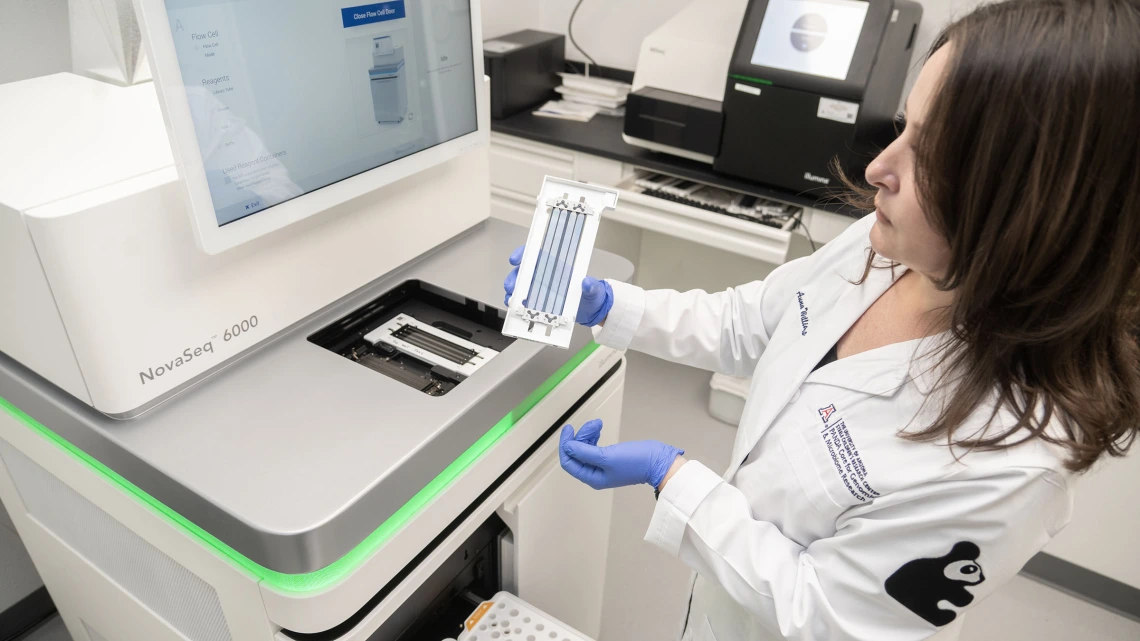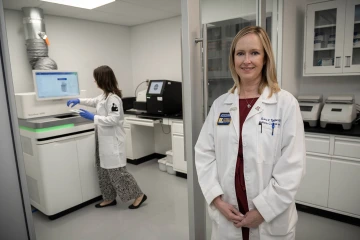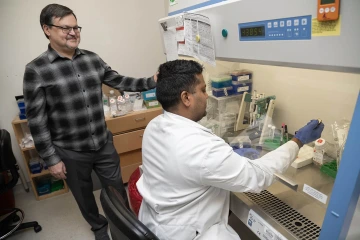Health Sciences genome sequencers a leap forward for research
Devices allow Health Sciences and other college collaborators greater scale and cost-effective methods to improve care.

Anna Williams prepares to load a flow cell into the PANDA Core for Genome and Microbiome Research’s NovaSeq 6000 genome sequencer. The flow cell is what DNA samples are pumped into and what they bind to as they’re processed into sequenced reads.
Finding when and where DNA changes as a disease progresses allows for better treatment of chronic, genetic-based diseases including cancer, diabetes, and neurological and developmental disorders.
At the University of Arizona, genome sequencers are used across multiple disciplines. But the newest genome sequencer in the UArizona Health Sciences offers the latest light-year jump in ability and technology.
Expanding capabilities, improving treatment
An Illumina NovaSeq 6000 System was purchased by the Steele Children’s Research Center Phoenix women’s board known as People Acting Now Discover Answers. The $1.3 million genome sequencer was installed last July at the center’s PANDA Core for Genomics and Microbiome Research in the Department of Pediatrics at the College of Medicine – Tucson. The center operates as the department’s research arm.

Daniel Laubitz, PhD, is the director of the PANDA Core for Genomic and Microbiome Research at the Steele Children’s Research Center.
“NovaSeq gives us completely new scale of sequencing,” said PANDA Core Director Daniel Laubitz, PhD.
Dr. Laubitz noted the Human Genome Project sequenced the first genome in 2003, taking 13 years and $3 billion to complete. Since then, genomic research has jumped light years. For instance, the PANDA Core’s older sequencer, an Illumina MiSeq unit, can generate 15 million-20 million reads of small pieces of sequenced DNA. The NovaSeq unit generates 20 billion reads times two, as it is two instruments in one.
“Now, with NovaSeq, we can sequence 48 whole human genomes within 40 hours. Our data can be used for diagnostic and basic science purpose,” Dr. Laubitz said. “The scale is completely different. Technology is completely different.”
Last month, the Steele Center was named beneficiary of Tucson’s Angel Charity for Children 2023 fund-raising campaign, which aims to collect $800,000. With that, five labs and one research office will be remodeled to provide genomic testing for children, said Pediatrics Department Chair and Steele Center Director Fayez Ghishan, MD.
“As a recipient for Angel Charity for Children’s funding, this year is going to be so exciting for kids in this community,” Dr. Ghishan told KVOA News4 Tucson. “Through these labs and the equipment we have, we will start whole genome sequencing to identify sick kids more quickly so the cost for treating them will be significantly lower.”
Advancing basic science, diagnostic possibilities
Dr. Laubitz is working with the UArizona Genetics Core for Clinical Services manager Taylor Edwards, MSc, PhD, to validate the PANDA Core’s NovaSeq capabilities to Clinical Laboratory Improvement Amendment, or CLIA, standards. This certification is a federal requirement before such labs can accept human samples for diagnostic testing. He expects validation to take up to three months or more.

Taylor Edwards, MSc, PhD, is associate staff scientist and clinical laboratory manager at the University of Arizona Genetics Core.
“Specifically, I’m trying to understand if timing and type of nutrition protects against organ dysfunction after surgery,” Dr. Typpo added.
“Having a team of researchers on genomic sequencers means that I can collaborate more closely with the team completing the work to have analysis tailored to my specific needs. It results in better science.”
Dr. Laubitz said the NovaSeq and MiSeq sequencers are available for research outside of pediatrics or health. For NovaSeq, that includes sequencing plant, soil or water samples for environmental and other purposes.
“We help get people to the right instrument or service for the most cost efficient, time efficient way of solving their genetic questions.”
Taylor Edwards, PhD
One PANDA Core example involved a soil microbiome study with UArizona College of Agriculture and Life Sciences researchers in Chile’s Atacama Desert, the driest spot-on Earth, to analyze changes after rainfall. Another example is a study on the role of gut microbiota on arsenic-contaminated soil toxicity led by Pawel Kiela, DVM, PhD, Steele Children’s Research Center associate director, Raina Maier, PhD, UArizona Superfund Research Center director, and CALS microbiologist Paul Carini, PhD.
For the UArizona Genetics Core, which is equipped with an Illumina NextSeq 550 and MiSeq unit, among project examples was sequencing for sub-variants of SARS-COV-2 throughout the pandemic.
“When COVID testing first started, we were on the ground already doing molecular work with a CLIA license,” Dr. Edwards said. “Very rapidly, we validated our PCR assay test. And then, we developed our COVID antibody test, which were offered free throughout the state and are now utilized by Dr. Jeff Burgess’ AZ HEROES group doing long-term studies on COVID. And, because we already have a high throughput pipeline, we can process thousands of samples a day for that.”

Katri Typpo, MD, MPH, Pediatrics Critical Care division chief (right), said having the new NovaSeq 600 on campus makes research faster, less expensive and more collaborative, which improves the quality of science.
David Harris, PhD, an immunobiology professor and executive director of the UArizona Health Sciences Biorepository, was honored for his role in COVID-19 testing early in the pandemic. His team created PCR sample kits and validated a rapid antigen test that showed active infections in real time. He said the antigen and PCR tests with the UArizona Genetics Core’s genomic analysis were crucial when time was of the essence.
The same is true for other research, Dr. Harris said. “Although we could farm out our genomics work, it would not be as timely or efficient to do so, delaying our analyses.”
Ruslan Rafikov, PhD, and Olga Rafikova, MD, PhD, College of Medicine – Tucson researchers investigating metabolic clues for earlier diagnosis of disease, initially pulmonary arterial hypertension, who also work extensively with AZGC, were in full agreement.
Collaboration, education for the future
Drs. Laubitz and Edwards said collaboration lies at the heart of their relationship. AZGC might do single-cell sequencing “library preparation” (breaking up a genomic DNA sample into a library of fragments to be sequenced) for a more complicated genomic project to be completed by the PANDA Core. In that way, they work together to more efficiently advance clients’ objectives and the science behind it.

Ruslan Rafikov, PhD, an associate professor, clinical translational sciences in the College of Medicine – Tucson, watches as Joel James prepares a sample for sequencing.
They also work cooperatively with other Health Sciences resources – whether proteomic, metabolic, genetic or genomic – to function as layered services taking advantage of strengths in one college, center or institute generally available across campus and beyond. And, since they’re university resources, the fee structure is focused on the cost of service rather than profit.
“We’re basically kind of a DNA for hire. We help get people to the right instrument or service for the most cost efficient, time efficient way of solving their genetic questions,” Dr. Edwards said.
Dr. Laubitz agreed. “We try to complement each other, and not really compete against one another.”
That benefits not just the researcher, but colleges, centers and institutes, too, Dr. Edwards added. “It helps, say, when the Arizona Cancer Center got re-designated, they were able to say, yes, part of our being effective here at the University of Arizona is we do have a genetics facility that’s able to do tumor profiling as needed.”

